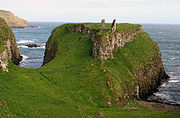
Dunseverick Castle
Encyclopedia

County Antrim
County Antrim is one of six counties that form Northern Ireland, situated in the north-east of the island of Ireland. Adjoined to the north-east shore of Lough Neagh, the county covers an area of 2,844 km², with a population of approximately 616,000...
, Northern Ireland
Northern Ireland
Northern Ireland is one of the four countries of the United Kingdom. Situated in the north-east of the island of Ireland, it shares a border with the Republic of Ireland to the south and west...
, near the small village of Dunseverick
Dunseverick
Dunseverick is a hamlet and townland near the Giant's Causeway in County Antrim, Northern Ireland. It is most notable for Dunseverick Castle.-External links:****...
and the Giant's Causeway
Giant's Causeway
The Giant's Causeway is an area of about 40,000 interlocking basalt columns, the result of an ancient volcanic eruption. It is located in County Antrim on the northeast coast of Northern Ireland, about three miles northeast of the town of Bushmills...
. Dunseverick Castle and earthworks are Scheduled Historic Monuments in the townland of Feigh, in Moyle District Council
Moyle District Council
Moyle District Council is a Local Council in County Antrim in the north-east corner of Northern Ireland. It covers a largely rural area of approximately 190 square miles and has a population of 15,000...
area, at grid ref: C9871 4467.
Dunseverick Castle and the peninsula on which it stands were given to the National Trust
National Trust for Places of Historic Interest or Natural Beauty
The National Trust for Places of Historic Interest or Natural Beauty, usually known as the National Trust, is a conservation organisation in England, Wales and Northern Ireland...
in 1962 by local farmer Jack McCurdy. The Causeway Cliff Path also runs past on its way to Dunseverick Harbour to the east and to the Giant's Causeway to the west.
History
Saint PatrickSaint Patrick
Saint Patrick was a Romano-Briton and Christian missionary, who is the most generally recognized patron saint of Ireland or the Apostle of Ireland, although Brigid of Kildare and Colmcille are also formally patron saints....
is recorded as having visited Dunseverick castle in the 5th century AD, where he baptized Olcán
Olcan
Olcán is the name of an early Irish saint of the Dál Riata, disciple of St Patrick and founder of Armoy in northeast Antrim.-Olcán and the Dál Riata:...
, a local man who later became a Bishop
Bishop
A bishop is an ordained or consecrated member of the Christian clergy who is generally entrusted with a position of authority and oversight. Within the Catholic Church, Eastern Orthodox, Oriental Orthodox Churches, in the Assyrian Church of the East, in the Independent Catholic Churches, and in the...
of Ireland. The original stone fort that occupied the position was attacked by Viking
Viking
The term Viking is customarily used to refer to the Norse explorers, warriors, merchants, and pirates who raided, traded, explored and settled in wide areas of Europe, Asia and the North Atlantic islands from the late 8th to the mid-11th century.These Norsemen used their famed longships to...
raiders in 870 AD.
In the later part of the 6th century AD, this was the seat of Fergus Mor MacErc (Fergus the Great). Fergus was King of Dalriada
Dalriada
Dalriada can refer to:* Dál Riata, a Gaelic kingdom in western Scotland and north-east Ireland in the Early Middle Ages* Dalriada School, a co-educational, voluntary grammar school in Ballymoney, Northern Ireland* Dalriada , Hungarian folk metal band...
and brother of the High King of Ireland, Murtagh MacErc. It is the AD 500 departure point from Ireland of the Lia Fail
Lia Fáil
The Lia Fáil , also known as the Coronation Stone of Tara, is a stone at the Inauguration Mound on the Hill of Tara in County Meath in Ireland, which served as the coronation stone for the High Kings of Ireland. In legend, all of the kings of Ireland were crowned on the stone up to Muirchertach...
or coronation stone. Murtagh loaned it to Fergus for the latter's coronation in western Scotland part of which Fergus had settled as his sea-kingdom expanded.
The O'Cahan
O'Cahan
O'Cahan is the name of a significant clan in Ulster, a province of Ireland. It has been angiclized to O'Kane, Kane and variations including, O'Keane, O'Kean, O'Keen, O'Keene, Keen, Keene, Kain, O'Kaine, and similar variations thereof. They are descended from Eógan, son of Niall of the Nine Hostages...
family held it from circa 1000 AD to circa 1320 AD, then regained it in the mid 16th century. Last one to have the castle was Giolla Dubh Ó Catháin, who left it in 1657 to settle in the Craig/Lisbellanagroagh area. Post 1660 they use the anglicised name McCain/O'Kane.
The castle was captured and destroyed by General Robert Munro in 1642 and his Cromwell
Oliver Cromwell
Oliver Cromwell was an English military and political leader who overthrew the English monarchy and temporarily turned England into a republican Commonwealth, and served as Lord Protector of England, Scotland, and Ireland....
ian troops in the 1650s, and today only the ruins of the gatelodge remain. A small residential tower survived until 1978 when it eventually surrendered to the sea below.
It was a 'key' ancient site in Ireland
Ireland
Ireland is an island to the northwest of continental Europe. It is the third-largest island in Europe and the twentieth-largest island on Earth...
. One of the royal roads from Tara, seat of the Kings of Ireland ended at Dunseverick castle.

